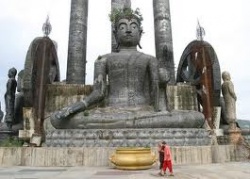Wat Tham Krabok
Wat Tham Krabok (Thai: วัดถ้ำกระบอก, literally Temple of the Bamboo Cave) is a Buddhist temple (wat) in Thailand, located in the Phra Phutthabat district of Saraburi Province, Thailand.
The temple was first established as a monastery in 1957 by the Buddhist nun Mian Parnchand (generally known as Luang Por Yai) and her two nephews, Chamroon and Charoen Parnchand, who had both ordained as monks at Wat Khlong Mao in Lopburi Province, Thailand. Luang Por Chamroon, a former Thai policeman, was the first abbot, although Wat Tham Krabok is not officially a Buddhist temple, but is a "Samnak Song", because it follows the teachings of Luang Por Yai, a woman. Still, the entrance claims it is a temple or Wat. The temple is majestic in its appearance, with two elephants supporting a globe marking its entrance. There are many large Buddha images on the temple grounds.
Hmong refugees
Following the end of the Vietnam War, in the late 1970s, Wat Tham Krabok hosted Hmong refugees in a camp on its grounds, most of whom fled Laos alleging that they were persecuted by the communist government that has ruled Laos since 1975. This continued until over 15,000 Hmong were allowed to go to the USA in 2004 and 2005.
In the late 1970s Wat Tham Krabok, and particularly its abbot, Luang Por Chamroon, supported the Hmong armed resistance against the Lao PDR government, particularly the Chao Fa movement led by Pa Kao Her. The Hmong were United States war allies in the Secret War against the communist Pathet Lao, the Viet Cong and North Vietnam.
When several Thailand-based Hmong refugee camps closed due to a lack of financial support in the early 1990s, Hmong refugees in Thailand fled to the temple to avoid repatriation to Laos. The population at the temple quickly grew to about 35,000, although it later declined significantly.
Wat Tham Krabok and its Hmong refugees drew global attention in the mid-1990s, as they became the subject of a major global political debate over their future. The government of Thailand, with support from the United Nations and the Clinton administration, sought to repatriate the Hmong at Wat Tham Krabok to Laos. But this effort drew significant opposition from American conservatives and human rights leaders, especially Hmong groups. Michael Johns, the influential former Heritage Foundation foreign policy analyst and aide to former President George H. W. Bush, helped lead opposition to the forced repatriation, labeling it a "betrayal," since many Hmong had aided the United States during the Secret War.
While some Hmong were repatriated, most were resettled to the United States in 2004 and 2005, most moving to the U.S. states of Minnesota, California, and Wisconsin. There are presently only a couple of Hmong families living at Wat Tham Krabok.
Drug rehabilitation and trafficking
Wat Tham Krabok has also received global attention for its heroin and opium drug rehabilitation program, which was started in 1959. Over 100,000 heroin and opium addicts have since gone through the unique Wat Tham Krabok detox program, a program consisting of Buddhist meditation, Asian herbal supplementation used for relaxation, induced vomiting, and the consumption of a secret detoxification potion composed of many different herbs. In 1975, Luang Por Chamrun Parnchand was awarded the prestigious Ramon Magsaysay Award for the temple's drug rehabilitation work.
A number of prominent Western drug users have sought treatment for their addictions at Wat Tham Krabok, including British punk rock musician Pete Doherty, Irish rock music singer Christy Dignam of Aslan, American computer underground personality Patrick K. Kroupa and British singer songwriter Tim Arnold.
In 2004, Tim Arnold's success story was the subject of many news articles in the UK. After completing his programme Arnold subsequently became a permanent Tham Krabok resident and favourite 'son' of the monastery's abbot, Luang Por Charoen.
Because opium used to be commonly grown and consumed by the Hmong in the highlands of Thailand and Laos, many Hmong refugees have undergone addiction treatment at Wat Tham Krabok. Wat Tham Krabok also supports the detoxification of those addicted to alcohol and methamphetamines.
Wat Tham Krabok was believed to have served as a conduit for international heroin and opium trafficking and possible arms trafficking to Hmong insurgents in Laos. Responding to these concerns, the Thai military deployed hundreds of troops to surround Wat Tham Krabok in April 2003. The Thai military and police fenced the Hmong at Wat Tham Krabok with concertina wire in an effort to monitor and control entrance to it, before they were able to immigrate to the USA in 2004 and 2005. The area is no longer fenced.
Global intrigue
Wat Tham Krabok's historic role in harboring Hmong refugees in the 1990s and early 2000s, and its global reputation for unique Buddhist approaches to lifestyle management and detoxification, have made the temple a popular destination for foreign tourists and drug addicts in Thailand. There have, however, been concerns that Wat Tham Krabok played a role as a conduit for weapons and military support to Hmong military insurgents, who are engaged in a military conflict against the communist Pathet Lao government in neighboring Laos. That support has, however, ended.
